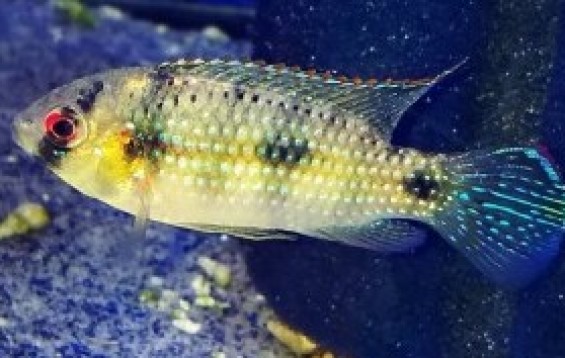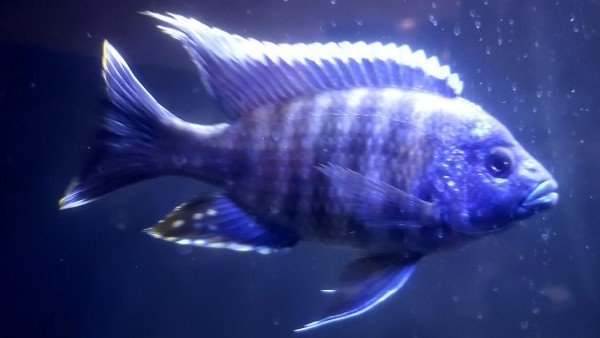- Name:
African Butterfly Cichlid
- Family: Cichlidae
- Species: African Cichlids
- Scientific Name: Anomalochromis thomasi


More Details
General info about African Butterfly Cichlid
African Butterfly Cichlids are typically a bright yellow-orange in color with darker stripes and spots. They have large, sweeping fins and a long, slender body. Adults can reach up to 4-5 inches in size.
The African Butterfly Cichlids are relatively easy to care for and can thrive in a variety of tank conditions. They prefer a well-oxygenated tank with plenty of hiding places and a sandy substrate. They should be fed a variety of foods, including flakes, pellets, live/frozen food, and vegetables. They should also be given regular water changes and tank maintenance.
African Butterfly Cichlids (Anomalochromis thomasi) are a species of freshwater fish native to West Africa. They are often referred to as "Butterflies" due to their colorful fins and body. African Butterfly Cichlids are a popular choice for freshwater aquariums, as they are relatively easy to care for and make a beautiful addition to any tank.
African Butterfly Cichlids are an excellent choice for freshwater aquariums. They are relatively easy to care for and make a beautiful addition to any tank. African Butterfly Cichlids are also known for their peaceful nature, and can easily be kept with other fish species.
The Anomalochromis thomasi African Butterfly Cichlids are part of the Cichlidae family, which includes many other popular aquarium species such as Angelfish and Discus. They are typically a bright yellow-orange in color with darker stripes and spots. Adults can reach up to 4-5 inches in size and can live up to 8-10 years in captivity. African Butterfly Cichlids are omnivorous, meaning that they will eat both plant and animal matter. They prefer to live in a well-oxygenated tank with plenty of hiding places and a sandy substrate.
In the wild, African Butterfly Cichlids are generally peaceful, though they can become territorial when breeding. They feed on a variety of plant and animal matter, including worms, crustaceans, and insects. They are also known to feed on the eggs of other fish species. African Butterfly Cichlids are also known to be very protective of their eggs and fry.
When selecting a tank for African Butterfly Cichlids, it is important to consider the size and layout of the tank. A minimum tank size of 30 gallons is recommended for a single fish, and larger tanks are necessary for multiple fish. The tank should include plenty of hiding places and a sandy substrate.
African Butterfly Cichlid Diet & Nutrition
African Butterfly Cichlids are omnivorous and will eat both plant and animal matter. A variety of foods, including flakes, pellets, live/frozen food, and vegetables, should be offered. It is also important to provide a balanced diet to avoid malnutrition.
Determining Sex of African Butterfly Cichlid
African Butterfly Cichlids can be difficult to sex, as the males and females look very similar. However, males tend to be larger and more brightly colored than females.
Breeding & Spawning African Butterfly Cichlid
African Butterfly Cichlids are egg-layers and will lay their eggs on flat surfaces, such as rocks or logs. The male will then guard the eggs and fry until they are able to fend for themselves. The eggs will typically hatch within 2-3 days, and the fry will reach maturity in 4-6 weeks.
African Butterfly Cichlid Origin
African Butterfly Cichlids are native to West Africa, where they inhabit lakes and rivers. They prefer slow-moving waters with plenty of vegetation, rocks, and other hiding places. African Butterfly Cichlids are typically found in small schools or shoals.
Caution with African Butterfly Cichlid
When keeping African Butterfly Cichlids, it is important to provide a well-oxygenated tank with plenty of hiding places and a sandy substrate. A balanced diet should also be offered, as well as regular water changes and tank maintenance. It is also important to monitor the water quality and perform regular water changes to prevent the spread of disease.
Acclimating African Butterfly Cichlid
When introducing African Butterfly Cichlids to a new tank, it is important to acclimate them slowly to the new environment. It is also important to monitor the water quality and perform regular water changes to prevent the spread of disease.
Relevent Articles
Original Detail
| Name | Species | Family | Scientific Name | More Detail | Added by |
|---|---|---|---|---|---|
| African Butterfly Cichlid | African Cichlids | Cichlidae | Anomalochromis thomasi | African Butterfly Cichlids are typically a bright yellow-orange in color with darker stripes and spots. They have large, sweeping fins and a long, slender body. Adults can reach up to 4-5 inches in size. The African Butterfly Cichlids are relatively easy to care for and can thrive in a variety of tank conditions. They prefer a well-oxygenated tank with plenty of hiding places and a sandy substrate. They should be fed a variety of foods, including flakes, pellets, live/frozen food, and vegetables. They should also be given regular water changes and tank maintenance. African Butterfly Cichlids (Anomalochromis thomasi) are a species of freshwater fish native to West Africa. They are often referred to as "Butterflies" due to their colorful fins and body. African Butterfly Cichlids are a popular choice for freshwater aquariums, as they are relatively easy to care for and make a beautiful addition to any tank. African Butterfly Cichlids are an excellent choice for freshwater aquariums. They are relatively easy to care for and make a beautiful addition to any tank. African Butterfly Cichlids are also known for their peaceful nature, and can easily be kept with other fish species. The Anomalochromis thomasi African Butterfly Cichlids are part of the Cichlidae family, which includes many other popular aquarium species such as Angelfish and Discus. They are typically a bright yellow-orange in color with darker stripes and spots. Adults can reach up to 4-5 inches in size and can live up to 8-10 years in captivity. African Butterfly Cichlids are omnivorous, meaning that they will eat both plant and animal matter. They prefer to live in a well-oxygenated tank with plenty of hiding places and a sandy substrate. In the wild, African Butterfly Cichlids are generally peaceful, though they can become territorial when breeding. They feed on a variety of plant and animal matter, including worms, crustaceans, and insects. They are also known to feed on the eggs of other fish species. African Butterfly Cichlids are also known to be very protective of their eggs and fry. When selecting a tank for African Butterfly Cichlids, it is important to consider the size and layout of the tank. A minimum tank size of 30 gallons is recommended for a single fish, and larger tanks are necessary for multiple fish. The tank should include plenty of hiding places and a sandy substrate. | PalaciosAn |
Changed by users
| Submitted Date | Submitted By | Status | Action |
|---|






